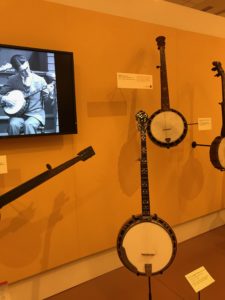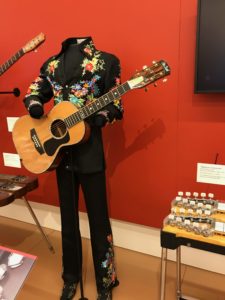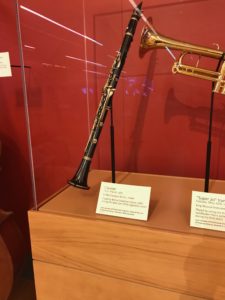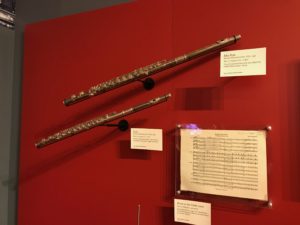
Martin Guitar Display
A trip to Arizona for spring training baseball offered my buddy Jim and I the opportunity to visit the Musical Instrument Museum in Phoenix last week. It was our first visit there, but certainly not our last. Located just north of Scottsdale, the museum sits off the freeway in an otherwise isolated area. One is immediately struck by the sheer size of the building itself, much larger than one might think.

Largest Upright Bas
After paying the entry fee (one day for $20, two days for $30), you are given a receiver and set of headphones to access audio samples at various stations throughout the exhibits. The first room we entered on the lower floor centered around the tallest bass I’ve ever seen. My buddy Jim Delfel is not a short man, but he was dwarfed by this towering structure
Moving up to the second floor, the museum groups exhibits geographically in large rooms that flow naturally into the next.
Our time there was limited so we spent the majority of our time in the USA-Canada, Europe and Latin America rooms. If one were to see the entire museum, it is strongly recommended to get the two day pass. You will need it.

Banjo from the 1800s
Being a bluegrass banjo player, I had wondered if there would be any banjos. There were many, from the early gourd banjos to the open backs to the resonator banjos commonly used today

Resonator Banjos
There was even a electric tenor banjo, built in 1938 by Gibson. This banjo was part of a collection loaned to the museum by John Jorgenson.

Electric Banjo
A number of instruments on display were played by well known musicians crossing many genres and time periods.

John Jorgensen Collection
There was Tommy Tedesco’s telecaster, lead guitarist for the Wrecking Crew. Hundreds of recordings that are a part of the music of the 1960s and 1970s came from this guitar. The very drum set that The Who’s Keith Moon detonated on national TV in 1967 on the Smothers Brothers Comedy Hour. I recalled watching that as a young teen and here was that drum set.

Tommy Tedesco’s Telecaster
Plenty of other celebrated instruments were on display; Hank Thompson’s and Marty Robbins’ guitars and Nudie suits and a guitar played by the great John McLaughlin

Hank Thompson’s Guitar & Nudie Suit
An area devoted to jazz had the clarinets of Benny Goodman and Artie Shaw, as well as the trumpets of Harry James and the great Miles Davis. Herbie Mann’s flute, along with a video of him in concert with it was a treat to both the eyes and ears.
Electronic music was represented in part by a Prophet analog synth donated by Peter Wolf, a mini Moog and a

Marty Robbins Guitar & Nudie Suit
theremin dated somewhere from 1929-31.
A fascinating display area created by Martin Guitar Company (see our cover photo), showed guitars in the various stages of construction, along with an explanation video and photos of the members of the Martin family who have overseen this company since the 1800s.
You will notice that I have not yet left the USA-Canada room. This portion of the trip took over two hours, and I have only touched on the highlights.

Benny Goodman’s Clarinet
Time was running short so I blasted through the rooms devoted to Europe and Latin America. I never entered the areas for Asia and Africa. But I was resolved to return next time I am in Phoenix.
Any lover of music will find a visit to the Musical Instrument Museum enjoyable. Musicians and instrument builders will find it a must-visit. And if you visit once, you will plan to return.

Herbie Mann’s Flute
Al Price contributed this article. Al plays and teaches banjo in Auburn, Washington. He works by day in sales and marketing for Nechville Banjos and plays banjo for the Rusty Hinges Bluegrass Band.
